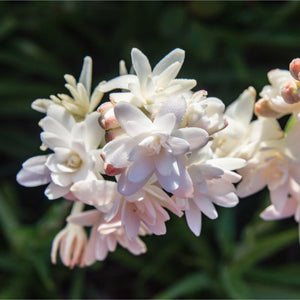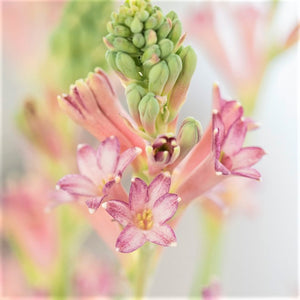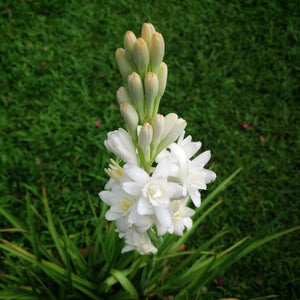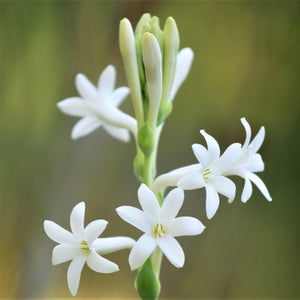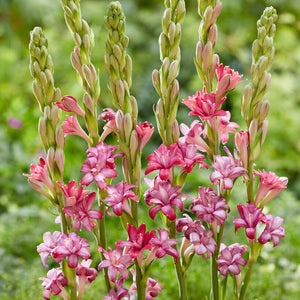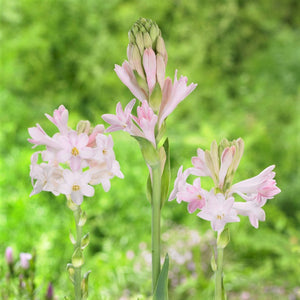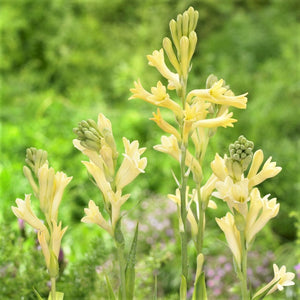- Home
- Planting Guides
- Tuberose Planting & Growing Guide
Tuberose Planting & Growing Guide
If you're a gardener who loves sweet, floral-scented blossoms, then you simply must plant Tuberose! Widely regarded as some of the most fragrant flowers in the world, these plants produce clusters of gorgeous, large, pure white blooms on stalks growing up to 4' tall. It's no wonder these beauties are so popular among florists for weddings and other special events! Native to Mexico, Tuberose are ideally suited to warm weather gardens, but those in cooler regions can grow them just as well in sunny sites. Learn more with this helpful guide.
Success Snapshot
PLANTING
DEPTH
2-3"

WATER
QUANTITY
Moderate
SUNLIGHT
QUANTITY
Full to Partial Sun; Bright Direct Indoors
PLANTING
PROXIMITY
6-8" Apart
BLOOM
SEASON
Summer - Fall
HARDINESS
ZONES
Zones 9-11
Shop Related Products

Tuberose - Pink Sapphire
$13.95
Contains: 3 Tuberose bulbs
Botanical Name: Polianthes tuberosa 'Pink Sapphire'
Exposure: Full Sun to Partial Sun
Hardiness: Zones 9-11 or indoors
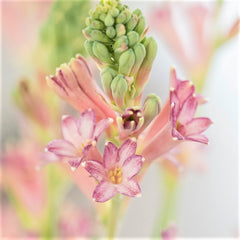
Tuberose - Cinderella
$17.95
Contains: 3 Tuberose bulbs
Botanical Name: Polianthes tuberosa 'Cinderella'
Exposure: Full Sun to Partial Sun
Hardiness: Zones 9-11 or indoors

Tuberose - White Double Form
$11.95
Contains: Tuberose bulbs. Choose from available pack sizes.
Botanical Name: Polianthes tuberosa 'The Pearl'
Exposure: Full Sun to Partial Sun
Hardiness: Zones 9-11 or indoors

Tuberose - White Single Form
$6.95
Contains: Tuberose bulbs. Choose from available pack sizes.
Botanical Name: Polianthes tuberosa
Exposure: Full Sun to Partial Sun
Hardiness: Zones 9-11 or indoors

Tuberose - Cherry
$17.95
Contains: 3 Tuberose bulbs
Botanical Name: Polianthes tuberosa 'NCYU Cherry'
Exposure: Full Sun to Partial Sun
Hardiness: Zones 9-11 or indoors

Tuberose - Sensation
$17.95
Contains: 3 Tuberose bulbs
Botanical Name: Polianthes tuberosa 'Sensation'
Exposure: Full Sun to Partial Sun
Hardiness: Zones 9-11 or indoors
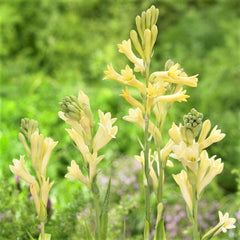
Tuberose - Yellow Baby
$17.95
Contains: 3 Tuberose bulbs
Botanical Name: Polianthes tuberosa 'Yellow Baby'
Exposure: Full Sun to Partial Sun
Hardiness: Zones 9-11 or indoors
Where to Plant
Whether planting in the ground or containers, make sure your Tuberose bulbs receive well-drained soil and full-day sun (light shade is fine in very hot, dry regions). If you notice puddles of water 5–6 hours after a hard rain, scout out another site or amend the soil with organic material to raise the level 2–3 inches. These plants are remarkably easy to grow but will not thrive in waterlogged soil.
When to Plant
Tuberose bulbs are best planted outdoors in early spring after the danger of frost has passed and the daytime temperatures remain above 70 degrees. These plants typically bloom from mid to late summer or around 90 to 120 days after planting.
How to Plant
- For outdoor landscape planting, find a spot where your plants will receive plenty of sun and well-drained soil. Dig holes and plant the bulb clumps 8 to 10" apart with 2 to 3" of soil above the tops.
- For container planting, start with good quality, well-drained potting soil and containers with adequate drainage holes. Dig holes and plant the bulb clumps 8 to 10" apart with 2 to 3" of soil above the tops.
- Water thoroughly after planting, soaking the soil to settle it around the bulbs.
How to Grow
- Water regularly during active growth if rain does not occur, with about 1 to 1.5" of total water per week as a fair estimate.
- Apply a balanced fertilizer (such as 8-8-8) to your plants each month while they are actively growing.
- Leave the foliage in place after blooming has finished for the season. The leaves will gather sunlight to create food through photosynthesis, strengthening the bulb for the future.
- Remove the dry foliage when the leaves turn yellow and die back later in the season.
- Allow your Tuberose to rest for a few months in dormancy before beginning the next growing cycle.
Tuberose Tips & Tricks
- Remember to fertilize your Tuberose plants, as these beauties are heavy feeders.
- Amend the soil with ground bark, decomposed manure, or compost to improve drainage and encourage a healthy start.
- Expect your Tuberose to arrive as substantial clumps containing multiple bulbs.
- Ensure your containers have adequate drainage holes, as Tuberose must never sit in waterlogged soil.
- Save your Tuberose for next year (if you're gardening in zone 8 or colder) by carefully digging up the bulbs after the first frost. Allow the bulbs to air dry for several days before storing them in a cool, dry location.
- Feel free to snip stems for fragrant summer bouquets when in bloom, as doing so will not hurt your plants and actually promotes the production of new flower spikes.
- Keep in mind that weekly deep waterings are better than lighter drinks every day or two.

